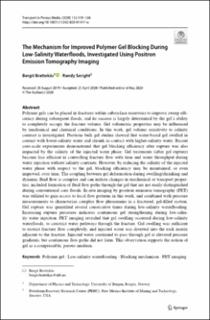| dc.contributor.author | Brattekås, Bergit | |
| dc.contributor.author | Seright, Randall S. | |
| dc.date.accessioned | 2021-07-16T09:45:54Z | |
| dc.date.available | 2021-07-16T09:45:54Z | |
| dc.date.created | 2020-05-20T13:16:09Z | |
| dc.date.issued | 2020 | |
| dc.identifier.issn | 0169-3913 | |
| dc.identifier.uri | https://hdl.handle.net/11250/2764639 | |
| dc.description.abstract | Polymer gels can be placed in fractures within subsurface reservoirs to improve sweep efficiency during subsequent floods, and its success is largely determined by the gel’s ability to completely occupy the fracture volume. Gel volumetric properties may be influenced by mechanical and chemical conditions. In this work, gel volume sensitivity to salinity contrast is investigated. Previous bulk gel studies showed that water-based gel swelled in contact with lower-salinity water and shrunk in contact with higher-salinity water. Recent core-scale experiments demonstrated that gel blocking efficiency after rupture was also impacted by the salinity of the injected water phase. Gel treatments (after gel rupture) become less efficient in controlling fracture flow with time and water throughput during water injection without salinity contrasts. However, by reducing the salinity of the injected water phase with respect to the gel, blocking efficiency may be maintained, or even improved, over time. The coupling between gel deformation during swelling/shrinking and dynamic fluid flow is complex and can initiate changes in mechanical or transport properties, included formation of fluid flow paths through the gel that are not easily distinguished during conventional core floods. In-situ imaging by positron emission tomography (PET) was utilized to gain access to local flow patterns in this work, and combined with pressure measurements to characterize complex flow phenomena in a fractured, gel-filled system. Gel rupture was quantified several consecutive times during low-salinity waterflooding. Increasing rupture pressures indicates continuous gel strengthening during low-salinity water injection. PET imaging revealed that gel swelling occurred during low-salinity waterfloods, to constrict water pathways through the fracture. Gel swelling was sufficient to restrict fracture flow completely, and injected water was diverted into the rock matrix adjacent to the fracture. Injected water continued to pass through gel at elevated pressure gradients, but continuous flow paths did not form. This observation supports the notion of gel as a compressible, porous medium. | en_US |
| dc.language.iso | eng | en_US |
| dc.publisher | Springer | en_US |
| dc.rights | Navngivelse 4.0 Internasjonal | * |
| dc.rights.uri | http://creativecommons.org/licenses/by/4.0/deed.no | * |
| dc.title | The Mechanism for Improved Polymer Gel Blocking During Low-Salinity Waterfloods, Investigated Using Positron Emission Tomography Imaging | en_US |
| dc.type | Journal article | en_US |
| dc.type | Peer reviewed | en_US |
| dc.description.version | publishedVersion | en_US |
| dc.rights.holder | Copyright the authors 2020 | en_US |
| cristin.ispublished | true | |
| cristin.fulltext | original | |
| cristin.qualitycode | 2 | |
| dc.identifier.doi | 10.1007/s11242-020-01417-w | |
| dc.identifier.cristin | 1811912 | |
| dc.source.journal | Transport in Porous Media | en_US |
| dc.source.pagenumber | 119-138 | en_US |
| dc.relation.project | Norges forskningsråd: 280341 | en_US |
| dc.identifier.citation | Transport in Porous Media. 2020, 133, 119-138. | en_US |
| dc.source.volume | 133 | en_US |

